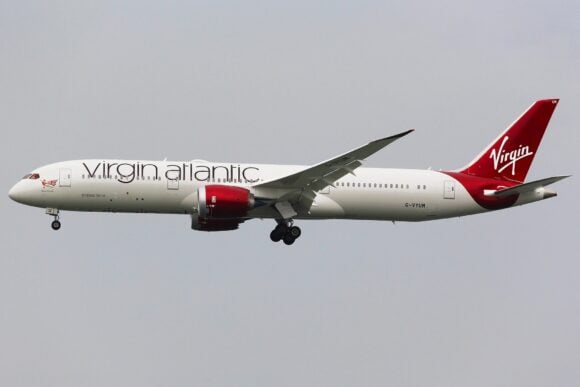
The initial report into the crash of Air India flight between Ahmedabad and Gatwick on June 12 states that while the aircraft achieved the maximum recorded airspeed of 180 knots IAS at about 08:08:42 UTC but immediately thereafter, Engine 1 and Engine 2 fuel cutoff switches transitioned from RUN to CUTOFF position one after another with a time gap of one second. Engine N1 and N2 began to decrease from their take-off values as the fuel supply to the engines was cut off (Air India Dreamliner crashes into Ahmedabad college hostel, kills over 240 | Reuters).
“In the cockpit voice recording, one of the pilots is heard asking the other why did he cutoff? The other pilot responded that he did not do so,” the initial report states. This is the first crash of a Boeing 787 since it started flying in 2011.
The initial report adds that the CCTV footage obtained from the airport showed Ram Air Turbine (RAT) getting deployed during the initial climb immediately after lift-off. No significant bird activity was observed in the vicinity of the flight path. The aircraft started to lose altitude before crossing the airport perimeter wall (Air India plane crash: US expert flags RAT deployment, points to ‘dual engine failure’ in disaster | What this means? | Today News).
The report has also ruled out contaminated fuel as one of the reasons for the accident. The initial report states that the fuel samples taken from the bowsers and tanks used to refuel the aircraft were tested at the Directorate General of Civil Aviation’s Lab and “found satisfactory.”
Both pilots had enough rest before the flight
Both pilots were based in Mumbai and had arrived at Ahmedabad on the previous day. They had an adequate rest period before operating the flight. The co-pilot was Pilot Flying (PF), and the PIC was Pilot Monitoring (PM) for the flight.
The initial report further states that fuel on board was 54,200 kg and as per the load and trim sheet of the flight, the take-off weight was 2,13,401 kg (max. allowed – 2,18,183 kg). The take-off weight was within allowable limits for the given conditions. There were no ‘Dangerous Goods’ on the aircraft.
Fatalities
The report states that there were 260 fatalities in the crash, including those on board the aircraft and on the ground. There were 242 passengers and crew on the ill-fated aircraft, of whom only one person survived the crash. The Boeing 787 aircraft involved in the accident was manufactured in 2013, and the last Airworthiness Review certificate was issued on May 22 this year, or 20 days before the crash, and was valid for a year, the report points out.
NTSB, USA appointed an Accredited Representative and Technical Advisers from Boeing, GE, and the Federal Aviation Administration (FAA) to assist in this investigation. A team led by the NTSB Accredited Representative, comprising representatives from Boeing, GE, and the FAA, arrived in Ahmedabad on June 15 and participated in the investigation. A team of officials from AAIB, UK, also arrived at Ahmedabad and visited the site with the DG, AAIB.
FAA SAIB of 2018 was not mandatory
The FAA issued Special Airworthiness Information Bulletin (SAIB) No. NM-18-33 on December 17, 2018, regarding the potential disengagement of the fuel control switch locking feature. This SAIB was issued based on reports from operators of Model 737 airplanes that the fuel control switches were installed with the locking feature disengaged. The airworthiness concern was not considered an unsafe condition that would warrant an airworthiness directive (AD) by the FAA. The fuel control switch design, including the locking feature, is similar on various Boeing airplane models, including part number 4TL837-3D, which is fitted in B787-8 aircraft VT-ANB.
As per the information from Air India, the suggested inspections were not carried out as the SAIB was advisory and not mandatory. The scrutiny of maintenance records revealed that the throttle control module was replaced on VT-ANB in 2019 and 2023. However, the reason for the replacement was not linked to the fuel control switch. There has been no defect reported pertaining to the fuel control switch since 2023 on VT-ANB.
The Aircraft was destroyed due to impact with the buildings on the ground and subsequent fire. A total of five buildings were impacted and suffered significant structural and fire damage.
After take-off, the aircraft impacted the BJ Medical College hostel, which is 0.9 Nautical Miles from the departure end of Runway 23. The Emergency Locator Transmitter (ELT) was not activated during this event. The wreckage, from the first impact point to the last identified aircraft item, was distributed in an area of approximately 1000 ft by 400 ft., the report states.
The next major check, the D Check, was due on this aircraft only in December 2025, the report states.
Air Traffic Control data shows that the aircraft sought permission for pushback and start up at 7:43 UTC, and its last call of MAY DAY was at 8:09:05 UTC.
No recommended actions at this stage for the aircraft or engine manufacturer
The initial report states that at this stage of the investigation, there are no recommended actions to B787-8 and/or GE GEnx-1B engine operators and manufacturers.
Boeing Statement after the report was made public
“We continue to support the investigation and our customer. We will defer to the AAIB to provide information about AI171, in adherence with the United Nations International Civil Aviation Organization protocol known as Annex 13.”
Views: 1183




